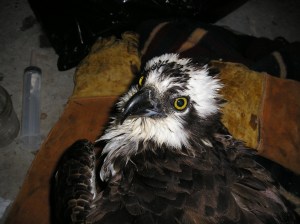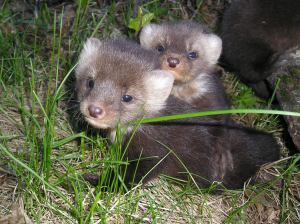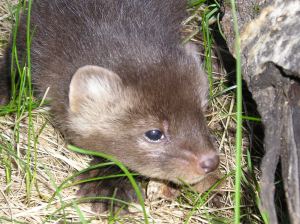Monthly Archives: May 2014
‘Marten’ up, okay???
I just wish human nature wasn’t what it is, and people didn’t think that their actions are necessarily the best ones to take.
Recently, I received a phone call from an old highschool pal regarding some baby animals young people he knew had ‘found’. Seems when they visited their remote cottage, three little martens had left their den in the eaves, likely curious as to their goings on.
Of course, they felt the need to rescue them, not knowing that mom would have been close by.
So, now I will be their mom, while their real mom ‘pines’ away for them.
Marten are mustelids, like weasel, mink, otter,fisher and wolverine and are known for their ferocity. Their main diet is voles, mice, birds, grouse, hares, and even blueberries and raspberries.
Like most mustellids, they cache extra food, as once they get killing, they can’t seem to stop. My chickens bear witness to that fact.
Marten were either extirpated or not present on the Kenora area until the mid-1950’s when marten were released at the Dogtooth Lake crown preserve. I remember when my father caught his first marten on his trapline. Still today, Marten are strictly managed to ensure their numbers stay strong.
Did you know the word Nokia is a Finnish name for marten, and the Croatian monetary kuna is a name for marten? They play an important part in civilization.
But for now, these little ones know nothing of their past, only interested in feeding time, play time and naps. They were about 40 days old when I got them, so they will be with me for a while more.
But I hear them screaming for their supper so I must serve them before they kill and eat each other.
mail (2048×1536)
Osprey, the other Haliaetus
A kind soul called me early one Saturday morning. He had seen an osprey on the ground the day before and had checked again that morning to find it was still there. He knew that it was in trouble and wondered if I could help. He willingly delivered it to me, and together we did an initial examination. There was no evidence of broken bones but it could not use one leg. The leg was swollen and hot, and while the bird could still open and close its talons, it wasn’t a coordinated movement. The bird was stressed so I held off the more thorough exam until I could give it time to calm down and a dose of Rescue Remedy. When I did check further, it appeared that there was an electrical burn on the side of the bird and another on the foot. Downy feathers had been singed along the leg as well. Possibly those same needle sharp, curved talons hooked around a hydro line during one of its short perching moments and while the bird while struggling to free itself touched its wings on both lines, receiving a shock. The prognosis was not good, but always worth a try. The biggest issue would be to get this extremely picky bird to eat and to take its medicine.
Osprey are grazers, not gulpers like hawks, owls and eagles. They pick tiny bits with their thin, hooked beak and slowly consume their catch. Sometimes a healthy young osprey can be enticed into feeding by tossing a small (but not too small) still flipping fish in front of them. Adults are not so easy. While tube feeding is possible in some birds, osprey can up their precious calories when in terror or stress. I would sit with it tucked under my arm until it appeared to be aware of its surroundings (they act stunned when in fear). Then I would slowly tuck a small bit of moistened mashed fish into the angle of its beak until it swallowed. It took nearly an hour to get 100 grams of fish into him for one meal. And a few hours later, I would start again. During this time, I had to protect not only its flight feathers from damage and fraying, but also its needle sharp talons. If the bird is released with dulled talons, it is likely to starve to death, as these are their tools for fishing.
But it was apparent that the injured leg had grown cold and this beautiful bird would not be releasable. I would be taking it to my vet to have it humanely euthanized the next morning. As it turned out, the trip was unnecessary as during its second night in care, it died.
It is of little comfort to know that this is a more than common result of osprey in rehabilitation. They are notoriously hard to help. But we tried. And I guess that counts for something.




